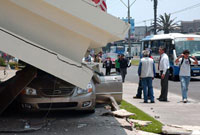Earthquake rocks Chile
A strong earthquake rattled the north of Chile, killing at least two and injuring more than 150 people. Chile's government was airlifting in hundreds of portable houses for people left homeless by the quake.

Medicines and food were also being sent, the government said, and a state of disaster was to be declared in several cities to allow allocation of emergency funds for help and reconstruction.
The 7.7 magnitude quake, centered in Chile's Atacama desert near the village of Quillagua, was so strong it was felt on the other side of the continent in Sao Paulo, Brazil. It damaged thousands of houses, blocked roads, crushed cars and knocked out power across northern Chile.
"It was incredible. I thought my last day had come when I saw the mountain shaking under a large cloud of dust," said Maria Ines Palete, a resident of Quillagua, which lies in the foothills of the Andes mountains.
The quake, which struck around midday Wednesday with an epicenter 1,260 kilometers (780 miles) north of Santiago, was followed by several aftershocks, including three larger than magnitude 5, according to the U.S. Geological Survey.
Hardest hit were the towns of Maria Elena, a 19th century nitrate mining camp, and Tocopilla.
In Tocopilla, 100 houses were destroyed and another 2,500, or 40 percent of the city's total, were damaged, said presidential spokesman Ricardo Lagos Weber.
Dr. Critian Castillo said 80 percent of the local hospital was destroyed and the government was sending a military emergency hospital.
Two women were killed in Tocopilla when their houses collapsed, authorities said.
Chile's government said it was flying 500 emergency housing units to Tocopilla and they should be installed by Thursday morning. Housing Minister Patricia Poblete said many of the damaged houses cannot be recovered and would have to be demolished.
Lagos Weber said about 170 people were taken to hospitals across the region, but that many of the injuries were not serious.
In Maria Elena, 1,200 homes were damaged - or 70 percent of the city's total, authorities said. Residents were still without running water, electricity and telephone service late Wednesday.
"I was at work and came home after the quake to find that I no longer have a house," said Julio Lopez, a Maria Elena resident.
At the badly damaged Lautaro restaurant in Maria Elena, a dozen men drank beer by candlelight.
"What else can I do? I lost everything. So I'll just have a few drinks," said Samuel Araya, a 57-year-old miner in this town of 7,000 people, which was once a nitrate mining center.
Blanca Pizarro said she took refuge under her kitchen table when the quake struck and seconds later the roof collapsed on the table. "I'm alive by a miracle," she said.
In Tocopilla, power was restored in most of the city after midnight but many people slept in their cars or in front of their dsamaged homes. Officials said many people refused to go to shelters fearing their homes wlould be looted if left unattended.
President Michelle Bachelet was expected to fly to northern Chile on Thursday.
Emergency bureau director Carmen Fernandez said 16 blocked roads were being cleared late Wednesday and power had been restored to about 85 percent of the region.
Chile's largest copper mines are in the quake area and production was halted as electric power was cut for several hours. But Codelco, which operates some of the largest mines, said the situation was back to normal by the end of the day. Chile is the world's largest copper producer.
About 10 road workers were trapped near Tocopilla when a section of a tunnel they were repairing collapsed, but all were in good condition and rescuers were working to free them, according to the emergency bureau.
Scientists were trying to determine why the quake apparently caused so little damage.
"The ground in the region is very good, very firm, so the movement's effect on buildings is limited," said Sergio Barrientos, a seismologist at the University of Chile.
"It comes down to the level of shaking in certain places," said Paul Earle at the USGS. "It's not immensely populated in the areas most affected."
The quake occurred in one of the most seismically active regions in the world, where the Nazca tectonic plate is shoving itself beneath the South American plate.
A 1939 quake in Chile killed 28,000 people and in 1960, a magnitude-9.5 quake - the strongest recorded in the 20th century - killed 5,700 people. On June 13, 2005, a magnitude-7.8 quake near Tarapaca in northern Chile killed 11 people and left thousands homeless.
Subscribe to Pravda.Ru Telegram channel, Facebook, RSS!




